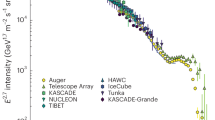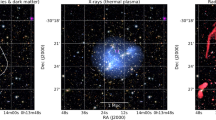Abstract
The issue of radiation mechanisms triggered in 1950–60s the first applications of plasma physics to understand the nature of radio galaxies. This interplay has steadily intensified during the past five decades due to the premise of in-situ acceleration of relativistic electrons occurring in the lobes of radio galaxies. This article briefly traces the chain of these remarkable developments, largely from an observational perspective. We recount several observational and theoretical milestones established along the way and the lessons drawn from them. We also present a new observational clue about in-situ acceleration of the relativistic particles radiating in the lobes of radio galaxies, gleaned by us from the very recently published sensitive radio observations of a tailed radio source in the galaxy cluster Abell 1033.


Similar content being viewed by others
Notes
Before 1970, the most comprehensive information about structures of radio galaxies came using the Cambridge one-mile telescope (Ryle 1962), which also yielded spectral gradients across some sources (MacDonald et al. 1968). However, the scope of this information was quite limited due to the small frequency range covered (408–1407 MHz) and the large beam size (\({\sim }80\) arcsec).
The lunar occultation technique for determining positions and brightness profiles of celestial radio sources was initially proposed by Getmantsev & Ginzburg (1950). It came into the limelight when its application by Hazard et al. (1963) paved the way for the discovery of the first quasar, 3C 273 (Schmidt 1963). The restoration technique for recovering the strip-brightness distribution from a lunar occultation profile, which required the removal of the effects of Fresnel diffraction at the Moon’s limb, was first developed by Scheuer (1962), von Hoerner (1964) and Cohen (1969). Early applications of this technique to radio galaxies and quasars are summarized in Taylor & de Jong (1968). Except for 3C 273, the occultations were observed using medium-size telescopes (the 140-ft or 85-ft dishes in the USA) and covering a narrow frequency range (200–500 MHz). Due to these constraining factors, these pioneering occultation observations yielded limited information on spectral index gradients across radio galaxies. Likewise, no significant information on spectral index gradients could be adduced from lunar occultation observations of six sources at 81.5 MHz (Collins & Scott 1969). The same holds for the occultation of 3C 212 reported at the very low frequency of 20–25 MHz (Bovkun 1976).
For a more general account of this, sometimes termed ‘youth-redshift degeneracy’, see Blundell & Rawlings (1999).
References
Alexander P. 1987, MNRAS, 225, 27
Alexander P., Leahy J. P. 1987, MNRAS, 225, 1
Arshakian T. G., Longair M. S. 2000, MNRAS, 311, 846
Athreya R. M., Kapahi V. K. 1998, JApA, 19, 63
Barai P., Wiita P. J. 2006, MNRAS, 372, 381
Begelman M. C., Blandford R. D., Rees M. J. 1984, RvMP, 56, 255
Berezhko E. G., Krymskii G. F. 1981, Sov. Astron. Lett., 7, 352
Blandford R. D., Rees M. J. 1974, MNRAS, 169, 395
Blandford R., Meier D., Readhead A. 2019, ARA &A, 57, 467
Blundell K. M., Rawlings S. 1999, Nature, 399, 330
Blundell K. M., Rawlings S. 2000, AJ, 199, 1111
Blundell K. M., Rawlings S. 2001, in eds Laing R. A., Blundell K. M., Particles and Fields in Radio Galaxies, ASP Conference Series., Vol. 250, p. 363
Blundell K. M., Rawlings S., Willott C. J. 2002, NewAR, 46, 75
Bolton J. G. 1956, PASP, 68, 477
Bovkun V. P. 1976, Sov. Astron., 19, 723
Bridle A. H., Perley R. A. 1984, ARA &A, 22, 319
Burbidge G. R. 1956, ApJ, 124, 4
Burch S. F. 1979, MNRAS, 186, 519
Capetti A., Zamfir S., Rossi P. 2002, A &A, 394, 39
Carilli C. L., Perley R. A., Dreher J. W. et al. 1991, ApJ, 383, 554
Chibueze J. O., Sakemi H., Ohmura T. et al. 2021, Nature, 593, 47
Christiansen W. 1969, MNRAS, 145, 327
Cohen M. H. 1969, ARA &A, 7, 619
Collins R. A., Scott P. F. 1969, MNRAS, 142, 371
Cotton W. D., Thorat K., Condon J. J. et al. 2020, MNRAS, 495, 1271
de Gasperin F., Intema H. T., Shimwell T. W. et al. 2017, Sci. Adv., 3, e10701634
Dennett-Thorpe J., Scheuer P. A. G., Laing R. A. et al. 2002, MNRAS, 330, 609
De Young D. S., Axford W. I. 1967, Nature, 216, 129
Edler H. W., de Gasperin F., Brunetti G. et al. 2022, A &A, 666, 3
Eilek J. A., Arendt P. N. 1996, ApJ, 457, 150
Eilek J. A., Melrose D. B., Walker M. A. 1997, ApJ, 483, 282
Ekejiuba I. E., Wiita P. J., Frazin R. A. 1994, ApJ, 434, 503
Enßlin T. A., Gopal-Krishna 2001, A &A, 366, 26
Fabian A. C. 2012, ARA &A, 50, 455
Fanaroff B. L., Riley J. M. 1974, MNRAS, 167, P31
Getmantsev G. G., Ginzburg V. L. 1950, JETP, 20, 347
Giri G., Vaidya B., Rossi P. 2022, A &A, 662, 5
Gopal-Krishna 1977, MNRAS, 181, 247
Gopal-Krishna 2021, Curr. Sci., 120, 1530
Gopal-Krishna, Biermann P. L., Gergely L., Wiita P. J. 2012b, RAA, 12, 127
Gopal-Krishna, Dabhade P. 2022, A &A, 663, 8
Gopal-Krishna, Mhaskey M., Mangalam A. 2012a, ApJ, 744, 31
Gopal-Krishna, Swarup G. 1977, MNRAS, 178, 265
Gopal-Krishna, Wiita P. J. 1987, MNRAS, 226, 531
Gopal-Krishna, Wiita P. J. 1990, A &A, 236, 305
Gopal-Krishna, Wiita P. J. 1991, ApJ, 373, 325
Gopal-Krishna, Wiita P. J. 2005, in eds Saha S. K., Rastogi V. K., 21st Century Astrophysics (New Delhi: Anita Publications) p. 108 (arXiv:astro-ph/0409761)
Gopal-Krishna, Wiita P. J., Saripalli L. 1989, MNRAS, 239, 173
Hardcastle M. J. 2013, MNRAS, 433, 3364
Hargrave P. J., Ryle M. 1974, MNRAS, 166, 305
Harris A. 1973, MNRAS, 163, 19P
Harwood J. J., Hardcastle M. J., Morganti R. et al. 2017, MNRAS, 469, 639
Hazard C., Mackey M. B., Shimmins A. J. 1963, Nature, 197, 1037
Högbom J. A. 1979, A &AS, 36, 173
Ishwara-Chandra C. H., Saikia D. J. 1999, MNRAS, 309, 100
Jaffe W. J., Perola G. C. 1973, A &A, 26, 423
Jamrozy M., Konar C., Machalski J. et al. 2008, MNRAS, 385, 1286
Jenkins C. L., Scheuer P. A. G. 1976, MNRAS, 174, 327
Jennison R. C., Das Gupta M. K. 1953, Nature, 172, 996
Jones T. W., Ryu D., Engel A. 1999, ApJ, 512, 105
Kaiser C. R., Alexander P. 1997, MNRAS, 286, 215
Kardashev N. S. 1962, Sv. Astr., 6, 317
Katz-Stone D. M., Rudnick L. 1997, ApJ, 488, 146
Kawakatu N., Kino M., Nagai H. 2009, ApJ, 697, L173
Kellermann K. I. 1966, ApJ, 146, 621
Kellermann K. I., Pauliny-Toth I. I. K., Williams P. J. S. 1969, ApJ, 157, 1
Klamer I. J., Ekers R. D., Bryant J. J. et al. 2006, MNRAS, 371, 852
Konar C., Hardcastle M. J. 2013, MNRAS, 436, 1595
Lal D. V. 2021, ApJ, 915, 126
Lal D. V., Rao A. P. 2005, MNRAS, 356, 232
Lal D. V., Rao A. P. 2007, MNRAS, 374, 1085
Lal D. V., Sebastian B., Cheung C. C. et al. 2019, AJ, 157, 195
Leahy J. P., Williams A. G. 1984, MNRAS, 210, 929
Liu R., Pooley G., Riley J. M. 1992, MNRAS, 257, 545
Loken C., Roettiger K., Burns J. O., Norman M. 1995, ApJ, 445, 80
Longair M. S., Ryle M., Scheuer P. A. G. 1973, MNRAS, 164, 243
MacDonald G. H., Kenderdine S., Neville A. C. 1968, MNRAS, 138, 259
Machalski J., Chyzy K. T., Stawarz A. et al. 2007, A &A, 462, 43
Mahatma V. H., Hardcastle M. J., Croston J. H. 2020, MNRAS, 491, 5015
Mangalam A. V., Gopal-Krishna 1995, MNRAS, 275, 976
McKean J. P., Godfrey L. E. H., Vegetti S. et al. 2016, MNRAS, 463, 3143
Merritt D., Ekers R. D. 2002, Science, 297, 1310
Miley G. 1980, ARA &A, 18, 165
Mills D. M., Sturrock P. A. 1970, ApL, 5, 105
Mitton S., Ryle M. 1969, MNRAS, 146, 221
Moffet A. T. 1966, ARA &A, 4, 145
Murgia M., Fanti C., Fanti R. et al. 1999, A &A, 345, 769
Myers S. T., Spangler S. R. 1985, ApJ, 291, 52
Nulsen P. E. J., Stewart G. C., Fabian A. C. 1984, MNRAS, 208, 185
O’Dea C. P., Daly R. A., Kharb P. et al. 2009, A &A, 494, 471
Pacholczyk A. G. 1970, Radio Astrophysics. Freeman, San Francisco, W.H
Pacholczyk A. G., Scott J. S. 1976, ApJ, 203, 313
Patra D., Joshi R., Gopal-Krishna 2023, MNRAS, 524, 3270
Perley R. A., Dreher J. W., Cowan J. J. 1984, ApJ, 285, L35
Pikelner S. B. 1953, Dokl Akad. Nauk. USSR, 88, 229
Rees M. J. 1971, Nature, 229, 312
Rieger F. M., Mannheim K. 2002, A &A, 396, 833
Riley J. M., Branson N. J. B. A. 1973, MNRAS, 164, 271
Rottmann H. 2001, PhD Thesis, U. Bonn
Rudnick L., Brüggen M., Brunetti G. et al. 2022, ApJ, 935, 168
Rudnick L., Katz-Stone D. M., Anderson M. C. 1994, ApJS, 90, 955
Ryle M. 1962, Nature, 194, 517
Ryle M. 1972, Nature, 239, 435
Safouris V., Subrahmanyan R., Bicknell G. V. et al. 2008, MNRAS, 385, 2117
Scheuer P. A. G. 1962, AuJPh, 15, 333
Scheuer P. A. G. 1974, MNRAS, 166, 513
Scheuer P. A. G. 1995, MNRAS, 277, 331
Schmidt M. 1963, Nature, 197, 104
Schmidt M. 1966, ApJ, 146, 7
Shklovskii I. S. 1953, AZh, 30, 15
Shklovskii I. S. 1955, AZh, 32, 215
Swarup G., Ananthakrishnan S., Kapahi V. K. et al. 1991, Cur. Sci., 60, 95
Swarup G., Sarma N. V. G., Joshi M. N. et al. 1971, Nature Phys. Sci., 230, 185
Swarup G., Thompson A. R., Bracewell R. N. 1963, ApJ, 138, 305
Taylor J. H. 1966, Nature, 210, 1105
Taylor J. H., de Jong M. L. 1968, ApJ, 151, 33
Tribble P. C. 1993, MNRAS, 261, 57
Turland B. D. 1975, MNRAS, 172, 181
Turner R. J., Shabala S. S. 2015, ApJ, 806, 59
van Breugel W. J. M. 1980, A &A, 81, 265
van der Laan H., Perola G. C. 1969, A &A, 3, 468
van Weerden R. J., Andrade-Santos F., Dawson W. A. et al. 2017, Nature Astron., 1, id. 0005
von Hoerner S. 1964, ApJ, 140, 65
Wiita P. J., Gopal-Krishna 1990, ApJ, 353, 476
Willis A. G., Strom R. G. 1978, A &A, 62, 375
Winter A. J. B., Wilson D. M. A., Warner P. J. et al. 1980, MNRAS, 192, 931
Zier C., Biermann P. L. 2001, A &A, 377, 23
Acknowledgements
We thank Henrik Edler for permission to republish Figure 1 and for providing the data used in plotting Figure 2. With the publication of this article, the authors will have co-authored 100 research publications. We take this opportunity to dedicate this article to the memory of Prof. Govind Swarup (1929–2020), who seeded radio astronomy in India and steered its course for the first five decades. GK is thankful to the Indian National Science Academy (INSA) for his current INSA Senior Scientist position.
Author information
Authors and Affiliations
Corresponding author
Rights and permissions
Springer Nature or its licensor (e.g. a society or other partner) holds exclusive rights to this article under a publishing agreement with the author(s) or other rightsholder(s); author self-archiving of the accepted manuscript version of this article is solely governed by the terms of such publishing agreement and applicable law.
About this article
Cite this article
Gopal-Krishna, Wiita, P.J. In-situ acceleration of radio-emitting particles in the lobes of radio galaxies: Evolving observational perspective and recent clues. J Astrophys Astron 45, 12 (2024). https://doi.org/10.1007/s12036-024-10000-4
Received:
Accepted:
Published:
DOI: https://doi.org/10.1007/s12036-024-10000-4




